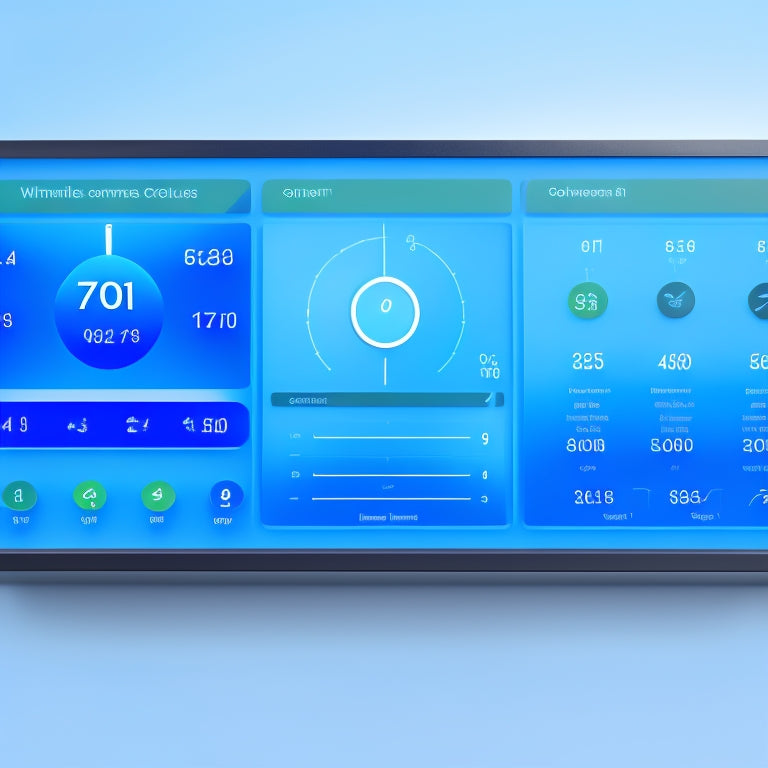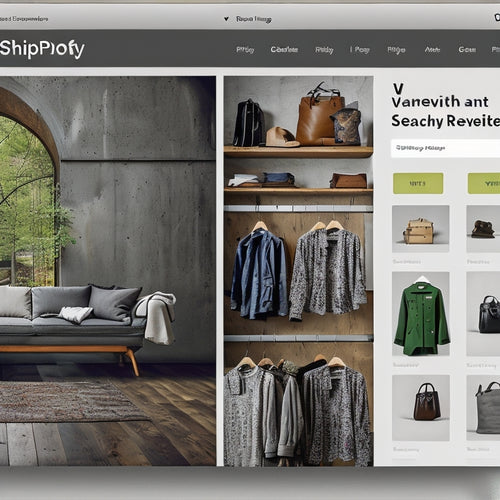
Measuring Success: Top Customer Experience Analytics Tools
Share
To measure success in customer experience, you need to track key metrics, identify pain points, and analyze customer interactions. It's essential to establish metrics that provide insight into customer behavior and sentiment, such as satisfaction levels, loyalty, and retention. By analyzing customer journey maps, you can visualize touchpoints and pinpoint areas of friction. Sentiment analysis metrics can help you gauge emotional customer responses, and identifying trends in customer feedback can reveal consistent patterns and preferences. To optimize your customer experience strategy, you'll want to use a tool that provides actionable insights. You're about to discover the top tools to help you do just that.
Key Takeaways
• Leverage metrics like customer satisfaction, loyalty, and retention to measure CX success and identify areas for improvement.
• Analyze customer journey maps to pinpoint pain points, opportunities, and emotional highs and lows, and refine CX strategy accordingly.
• Utilize sentiment analysis metrics, such as net promoter score and emotional response rates, to gauge emotional intensity and customer feelings.
• Track customer feedback to identify trends, patterns, and preferences, and build on business strengths to enhance CX.
• Choose analytics tools that provide actionable insights into customer behavior and sentiment, enabling data-driven decisions to drive growth and success.
Setting Up Customer Experience Metrics
To establish a solid foundation for customer experience analytics, you need to set up key metrics that accurately measure customer satisfaction, loyalty, and retention. By tracking satisfaction levels, you can identify areas where your business excels and where it falls short. This allows you to make data-driven decisions to improve customer interactions and boost overall experience.
When setting up your metrics, consider the following:
What're the most critical touchpoints in the customer journey?
Which metrics will provide the most insight into customer behavior and sentiment?
Uncovering Pain Points in Checkout
According to studies, nearly 70% of online shopping carts are abandoned, with a significant portion of these abandonments occurring during the checkout process, highlighting the need to identify and address pain points in this critical stage. As you delve deeper, you'll find that cart abandonment is often a result of poor user experience. To pinpoint the issues, you need to analyze the checkout process step-by-step.
Here are some common pain points to look out for:
| Pain Point | Impact on UX | Solution |
|---|---|---|
| Complex registration process | Frustration, abandonment | Offer guest checkout or simplify registration |
| Limited payment options | Inconvenience, abandonment | Add more payment methods, like PayPal or Apple Pay |
| Unexpected shipping costs | Surprise, anger | Clearly display shipping costs earlier in the process |
| Slow loading times | Frustration, impatience | Optimize page loading times and ensure a smooth experience |
| Lack of trust indicators | Anxiety, mistrust | Display trust badges, security certificates, and customer reviews |
Analyzing Customer Journey Maps
By examining customer journey maps, you can visualize the various touchpoints customers interact with when engaging with your brand, revealing areas of friction, opportunity, and emotional highs and lows. This journey map analysis helps you understand how customers navigate your brand, identifying pain points that hinder customer satisfaction.
By mapping touchpoints, you can pinpoint where customers experience frustration, delight, or indifference. This insight enables you to refine your customer experience strategy, optimizing interactions to boost satisfaction and loyalty.
Through journey map analysis, you can identify patterns and trends in customer behavior, revealing opportunities to improve engagement and conversion rates. By understanding customer emotions at each touchpoint, you can develop targeted strategies to alleviate frustration, amplify delight, and create memorable experiences.
This data-driven approach empowers you to make informed decisions, prioritizing initiatives that drive meaningful change and measurable results. By analyzing customer journey maps, you'll uncover actionable insights to elevate your customer experience, driving growth, and loyalty.
Measuring Emotional Customer Responses
You can gauge the emotional intensity of customer interactions by tracking sentiment analysis metrics, such as net promoter score, customer satisfaction, and emotional response rates. These metrics provide a quantitative measure of how customers feel about their experiences, allowing you to pinpoint areas that drive emotional engagement and customer loyalty.
By analyzing sentiment data, you can identify patterns and trends that reveal what's working and what's not in your customer experience strategy.
Understanding behavior is key to improving customer satisfaction. By examining the emotional responses of your customers, you can gain insights into their needs, preferences, and pain points. This information enables you to make data-driven decisions that enhance the customer experience, increasing loyalty and retention.
Effective emotional response measurement also helps you identify opportunities to surprise and delight customers, fostering a deeper emotional connection with your brand. By leveraging these metrics, you can create a customer-centric culture that drives business growth and success.
Identifying Trends in Customer Feedback
Identifying Trends in Customer Feedback
Customer feedback trends emerge when you sift through large datasets, revealing consistent patterns and preferences that can inform targeted improvements to the customer experience. By analyzing customer feedback, you can identify sentiment trends that indicate areas of strength and weakness in your business. Sentiment analysis, a key component of customer experience analytics, helps you quantify customer opinions and emotions, providing a deeper understanding of their needs and expectations.
You'll be able to pinpoint specific pain points, such as product features or customer service issues, that are driving negative sentiment. Conversely, you'll also identify areas where your business is excelling, allowing you to build on those strengths.
Visualizing Customer Experience Data
Visualizing Customer Experience Data
Effective visualization of customer experience data transforms complex insights into actionable intelligence, allowing you to quickly grasp patterns, trends, and correlations that might remain hidden in raw numbers. By leveraging data visualization tools, you can uncover hidden gems in your customer feedback, sentiment analysis, and other data points. This enables you to pinpoint areas of improvement, optimize customer engagement, and drive business growth.
Here are some key data visualization strategies to boost your customer experience analytics:
| Visualization Type | Benefits | Example |
|---|---|---|
| Heatmaps | Identify patterns and correlations | Visualizing customer sentiment by region |
| Bar Charts | Compare customer engagement metrics | Analyzing website traffic by device type |
| Scatter Plots | Reveal relationships between variables | Correlating customer satisfaction with purchase frequency |
Quantifying the Cost of Churn Rate
By analyzing the visualized customer experience data, it becomes clear that understanding the cost of churn rate is essential, as even a slight increase in customer retention can deeply impact revenue and profitability.
You'll want to calculate the customer lifetime value (CLV) to quantify the cost of churn rate. This metric represents the total revenue a customer generates for your business over their lifetime.
To calculate CLV, you'll need to know the average order value, purchase frequency, and customer lifespan. For instance, if the average order value is $100, customers make 5 purchases per year, and the average customer lifespan is 5 years, the CLV would be $2,500.
Now, let's say you have a 20% churn rate, which means you're losing 20% of your customers annually. If you have 1,000 customers, that's 200 lost customers per year, resulting in a loss of $500,000 (200 x $2,500).
Optimizing Customer Experience Scorecards
You can create a customer experience scorecard by tracking key performance indicators (KPIs) that provide a thorough view of your customers' experiences across various touchpoints. This scorecard helps you identify areas for improvement, enabling you to enhance customer satisfaction and loyalty. By monitoring KPIs such as Net Promoter Score (NPS), Customer Satisfaction (CSAT), and Customer Effort Score (CES), you can develop targeted strategies to improve retention rates and reduce churn.
| Metric | Target | Current Status |
|---|---|---|
| NPS | 40 | 30 |
| CSAT | 85% | 80% |
| CES | 4.5/5 | 4.2/5 |
Frequently Asked Questions
How Do I Prioritize Which Customer Experience Metrics to Track First?
You prioritize customer experience metrics by identifying key drivers of customer satisfaction, analyzing data to uncover feedback trends, and selecting metrics that align with business objectives, ensuring a data-driven approach to metric selection.
Can I Use Customer Experience Analytics Tools for B2B Businesses?
You can leverage B2B analytics to measure customer satisfaction, tracking metrics like net promoter score, customer effort score, and retention rates to gain insights that drive business growth and informed decision-making.
What Is the Ideal Sample Size for Customer Feedback Surveys?
As you flip a coin, the odds of getting it right are 50/50, but for customer feedback surveys, you need a sample size that guarantees survey response rates are high and results are statistically significant.
How Often Should I Refresh and Update My Customer Journey Map?
You should refresh your customer journey map quarterly, analyzing each touchpoint's performance, and involve stakeholders to guarantee accuracy; this frequency allows for timely adjustments to enhance the overall customer experience.
Are Customer Experience Analytics Tools Compatible With GDPR Regulations?
You're likely aware that 92% of Europeans say GDPR has given them more control over their data. When choosing customer experience analytics tools, make sure they prioritize GDPR compliance, robust data protection, and obtain explicit customer consent to avoid hefty fines.
Related Posts
-
Benefits of Video Integration on Shopify
In today's highly competitive online marketplace, businesses are constantly seeking innovative ways to enhance custo...
-

How Do I Customize My Search Results on Shopify
This article aims to provide an informative overview of the process of customizing search results on the Shopify pla...
-

How Do I Increase Shopify App Installs
This article aims to provide informative and data-driven insights on the topic of increasing Shopify app installs. T...

